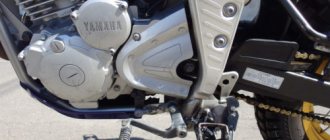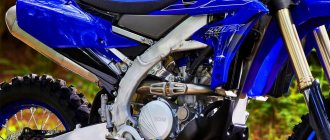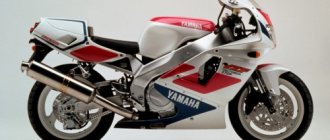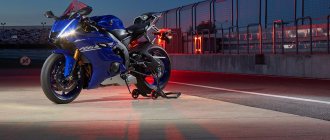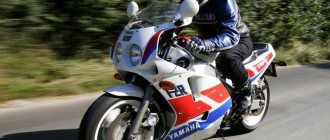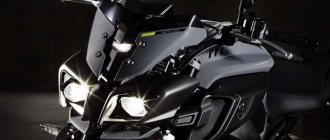Video
The Yamaha FZR 250
is a small-capacity sportbike that anticipated the appearance of such models as the Kawasaki Ninja 250 and the Honda CBR 250. Then, in the late 80s, when the FZR 250 was introduced, no one suspected that after some one and a half to two decades in In the segment of sports bikes for beginners, such serious competition will flare up. Now there are plenty of options in this niche, there is even a 50 cc Aprilia RS50, which requires only an M category license to drive and at the same time reaches a speed of 120 km/h. But the Yamaha FZR 250 motorcycle, produced from 1990 to 1998, was an excellent bike for its time. Moreover, it still remains relevant.
Everything about this motorcycle is made as simple as possible, with the goal of an inexperienced beginner in mind. It is all the more surprising that this friendliness is combined with excellent technical characteristics. The compression ratio in the 4-cylinder 16-valve 250 cc liquid-cooled engine is 12 to 1. The maximum power of the Yamaha FZR 250 is 45 horsepower, comparable to the modern Honda Hornet 250. Peak torque reaches 24.5 Newton meters. The FZR250 engine, by the way, loves high speeds, its power peaks at around 16,000 revolutions.
Adjacent to the technologically advanced high-speed engine is a 6-speed transmission, which also makes its contribution to the dynamics of the motorcycle, and the contribution, admittedly, is noticeable. The first two gears of the Yamaha FZR 250 are quite short, which allows the lightweight motorcycle to take off quickly, surprising others. Or, without surprising, you can’t tell from the bike that it only has 250cc, it looks just like an “adult”. Impressive visual dimensions are achieved mainly due to the plastic body kit, which conceals the silhouette. In fact, the FZR 250 is a lightweight motorcycle, its dry weight is just under 150 kilograms.
Thanks to its low weight and narrow (100mm front and 130mm rear) wheels, the motorcycle handles fabulously, which novice motorcyclists should appreciate. True, to maintain dynamics, the engine must be constantly kept in the upper speed range, but in this case, the dynamics of the Yamaha FZR 250 can pleasantly surprise. At least up to the hundred km/h mark on the speedometer - after about 100 km/h, the sportbike’s fuse disappears, and with some reluctance it picks up its rightful 140 km/h.
It is worth noting decent wind protection and a comfortable fit. Of course, wind protection at the speeds that the FZR 250 is capable of is not critical, but the piercing cold wind has never done anyone any good. The riding position is typical of a sportbike, leaning forward but generally comfortable and not putting any significant strain on the arms. With a height of 180 cm, as practice has shown, you can fit quite comfortably on a motorcycle, there is no feeling of cramping. It’s already a bit cramped for two people, of course, and the presence of a passenger doesn’t have the best effect on the dynamics of the Yamaha FZR 250.
This little sportbike imitates its older brothers in everything. It has a respectable size, a torquey engine, a sporty seating position and excellent brakes for its weight and dynamics - as many as three brake discs. All this makes the Yamaha FZR 250 an excellent option for the novice sport biker who wants a small sports bike, but does not have the budget to buy a more recent example.
The Yamaha FZR 400 RR is a sports motorcycle designed for the Japanese domestic market, produced from 1986 to 1994.
During its release, it underwent some changes - so, already in 1988, the motorcycle received a new reinforced pendulum, EXUP system and inertial supercharging, and in 1990 - a new, shortened frame, new carburetors and a new rear wheel, which had a positive effect on handling . In addition, in 1993, a small batch of motorcycles called the Yamaha FZR 400RR SP was released, featuring sportier carburetor settings, a single seat, a different clutch, different valve springs and fully adjustable suspension. Since there were very few SP version bikes produced, and this was more than two decades ago, these days it is quite difficult to find one, and even one that runs well. In general, the FZR 400RR is a bright representative of 400 cc sportbikes of those years, equipped, however, with the most advanced technologies of the 80s, with a discount on the general budget of all 400 cc motorcycles, of course. However, the need to keep the price at an affordable level did not prevent the engineer from equipping the light sportbike with the latest diagonal alloy frame at that time, a progressive rear monoshock absorber and a telescopic fork with preload adjustment. Its competitors of the same years, like the Kawasaki ZXR 400 and Honda CBR 400RR, could not boast of the same.
The liquid-cooled inline-four with 4 valves per cylinder produced 59 hp. and 39 Nm of torque, however, only until 1993, when, due to changes in Japanese legislation, all “four hundred” were limited in power to 53 hp. The Yamaha FZR 400 RR engine loves high revs, peaking at around 12,000 rpm, and the motorcycle can accelerate to an impressive speed of 200 km/h, with acceleration from 0 to 100 km/h taking only four and a quarter seconds.
Despite the ability to adjust the suspension to suit your needs, the overall chassis of the FZR 400 RR feels quite stiff, which is typical for sports bikes. The landing position is also what you would expect, looking at the elongated 15-liter gas tank and the clip-ons lowered down - with a forward tilt and a noticeable load on the arms. It’s hard to ride this bike for more than a couple of hours, your back gets tired, and your arms are begging for mercy, so you want to stop and rest a little. But the low weight is pleasing - the dry weight of the Yamaha FZR 400 RR is only 169 kg, which makes it easy to move it on the spot.
On the move, the lightweight sportbike also handles excellently, the frame does not try to “float” in long turns, and there is no feeling that the rear wheel of the motorcycle is starting to catch up with the front. It is also capable of sharp maneuvers - rigid suspensions help to perfectly hold the road and maneuver at almost any speed. But you should be careful with the throttle - the response to it is quite sharp, etc. Having ridden the FZR 400 RR for the first time, you can’t help but wonder – is it really only 400 cc? It’s hard to believe this, he’s so quick.
Despite its thoughtful and technological design, the Yamaha FZR 400 RR did not gain high popularity and did not gain the status of a legendary motorcycle, which was the reason for its discontinuation. However, even now this sportbike is of interest to novice motorcyclists, who often compare it with other bikes of similar price, such as the Kawasaki ZZ-R400.
Similar articles:
- Honda CBR 400 RR review
- Yamaha FZR 1000 Review
- Suzuki GSX-R400 review
- Yamaha YZF 750 review
- Yamaha FZ 750 Review
- Suzuki GSX-R250 review
LiveJournal
Brief history of the model
1986 – the start of production of the Yamaha FZR400. This year's models have a steel frame and are sold only in Japan. Model: Yamaha FZR 400 (Genesis) (Japan). Factory designation: 1WG.
1987 – the appearance of the sports modification Yamaha FZR400R. The model is distinguished by the presence of the EXUP system, a reinforced clutch and an oil cooler. Model: Yamaha FZR400R-SP (EXUP) (Japan). Factory designation: 2TK.
1988 – restyling of the model. In addition to Japan, the model is available in North America and Europe. The motorcycle receives the EXUP system in the basic version, inertial supercharging and a stainless exhaust. Model: Yamaha FZR 400 (Japan, North America, Europe). Factory designation: 3EN1, FZR400U 3BF (North American version, identical to generation 1WG), FZR400SUC 3FH (same, but with EXUP system).
1989 – the appearance of the sports modification Yamaha FZR400RR. Features a new swingarm and Deltabox frame, as well as an aluminum exhaust. The wheel size changes: 110/70-17 53H -> 120/60-17 55H; 140/60-18 64H -> 160/60-17 69H. The engine tilt changes: 45° -> 35°. The brakes are changed: the front ones become 4-piston, the rear ones - 2-piston. The fuel tank capacity is reduced from 18 to 15 liters. Model: Yamaha FZR400, FZR400RR (EXUP) (Japan, North America, Europe). Factory designation: 3TJ1, 3EN2, FZR400W 3BF, FZR400SWC 3FH.
1990 - The model receives increased traction and front suspension adjustment. The sports modification is available in a single-seat version (with a plug). Model: FZR400RR-SP (EXUP), FZR400 (Japan, North America). Factory designation: 3TJ2, FZR400A 3BF (North American model, identical to 1WG, but with Deltabox swingarm and 4-piston calipers like 3EN2), FZR400SAC 3FH (North American model, similar to previous one, but with EXUP).
1992 - only a sports modification remains on the market - Yamaha FZR400RR-SP. The motorcycle is only available in Japan and Europe. The model receives new Keihin FCR32 flat-choke carburetors and reduces maximum power to 53 hp. (due to changes in Japanese law). Model: FZR400RR-SP (EXUP) (Japan, Europe). Factory designation: 3TJ6; 4DX1, 4DX2 (Europe).
1994 is the last year of production of the Yamaha FZR 400 RR. The model is only available on the Japanese market. Model: FZR400RR-SP (EXUP) (Japan, Europe). Factory designation: 3TJ7.
Motorcycle Yamaha FZR 400RR SP EXUP 1992 review
Description of the motorcycle Yamaha FZR 400RR SP EXUP 1992 is in the queue for publication of the article. Announcement: Today, for almost every new motorcycle that comes into being, marketers strive to carve out their own niche. This one is a road sport, this one is a recreational enduro. But what class should we include a motorcycle that has a little bit of everything? A good bike should have a reliable engine, comfortable ergonomics and simple controls...
Yamaha FZR 400RR SP EXUP is a motorcycle not sold in Russia, equipped with a high-power 53 hp engine. Despite the fact that good models of motorcycles have a very respectable price, and the season for their use is relatively short, the motorcycle market is developing rapidly. And if you believe the words of dealers, then some models of recently released motorcycles are selling like hot cakes at the beginning of the season, and the models brought to Russia are clearly not enough to fully satisfy consumer demand.
A motorcycle has long ceased to be an alternative to a car, and the times when this equipment was bought only because there was not enough money for a full-fledged car are forgotten. Nowadays, two-wheelers can be called technological marvels in many cases, and their cost can be compared with that of prestigious cars.
Many people have started buying motorcycles for hobby purposes as riding or even collecting them has become a good pastime for many people. Many motorcycles, for example the Yamaha FZR 400RR SP EXUP, whose technical characteristics make it possible to call the model a prestigious brand, are in demand among both beginners and experienced motorcyclists.
Currently, it is impossible to purchase a new Yamaha FZR 400RR SP EXUP motorcycle from the 1992 model year, since their production stopped 24 years ago. At the same time, the Yamaha FZR 400RR SP EXUP has excellent technical characteristics, so many are eager to purchase, if not a new, then at least a used version.
Motorcycles with an engine capacity of 399 cc. see, appeared as a result of long work of inventors who sought to create a model that was not inferior in characteristics to other versions of the motorcycle. In some cases, these models are not only not inferior, but also ahead of other motorcycles, as they have minimal fuel consumption and other excellent parameters.
Motorcycles from 250 to 400 kb. see which includes the Yamaha FZR 400RR SP EXUP - this is the most common class of motorcycles. In this range you already have a choice among almost all classes of motorcycles. Many people call this category the most suitable for a first motorcycle. You can purchase a moderately heavy, powerful and flexible motorcycle for relatively little money. Many people advise taking a road bike with a 400 cc engine as your first choice. We cannot completely agree with this, because such motorcycles often weigh about 200 kg and have a sufficient power reserve. If your skills in riding a two-wheeled vehicle are limited to a training motorcycle at a motorcycle school, then you should not immediately take such a device. Many beginners get into ridiculous accidents simply because they do not know all the features of operating such equipment. After all, the heavier and more powerful the motorcycle, the better you should know how to handle it in different situations. Even a monkey can just drive in a straight line (no joke).
Go to the entire range of Yamaha motorcycles, on this page you can find Yamaha FZR 400RR SP EXUP motorcycles from other years of production and information about them
Brief history of the model
- 1986 – start of production of Yamaha FZR400
. - 1988 - the motorcycle is equipped with the EXUP system, which made it possible to somewhat reduce the dip at low speeds, inertial supercharging and a new reinforced pendulum. The official name of the model is Yamaha FZR400R
. - 1990 - the motorcycle receives a new frame, carburetors and a 17-inch rear wheel (instead of 18). Thanks to the new frame, the wheelbase is shorter and the weight of the motorcycle is reduced from 165 to 160 kg. The official name of the model is Yamaha FZR400RR
. - 1993 – a limited series of motorcycles with the SP index (Yamaha FZR400RR SP) is released onto the market. The model featured a single seat, sporty carburetor settings, fully adjustable suspension, reinforced valve springs and more clutch plates. In addition, the cooling radiator did not have a fan. Maximum power was 53 hp. (due to updated Japanese legislation, all 400cc motorcycles must be limited to 53 hp), but the bike easily revved up to almost 70 hp.
- 1994 – The Yamaha FZR400RR is officially discontinued.
Video
Yamaha FZR 400RR
- a sports motorcycle intended for the Japanese domestic market, produced from 1986 to 1994. During its release, it underwent some changes - so, already in 1988, the motorcycle received a new reinforced pendulum, EXUP system and inertial supercharging, and in 1990 - a new, shortened frame, new carburetors and a new rear wheel, which had a positive effect on handling . In addition, in 1993, a small batch of motorcycles called the Yamaha FZR 400RR SP was released, featuring sportier carburetor settings, a single seat, a different clutch, different valve springs and fully adjustable suspension. Since there were very few SP version bikes produced, and this was more than two decades ago, these days it is quite difficult to find one, and even one that runs well.
In general, the FZR 400RR is a bright representative of 400 cc sportbikes of those years, equipped, however, with the most advanced technologies of the 80s, with a discount on the general budget of all 400 cc motorcycles, of course. However, the need to keep the price at an affordable level did not prevent the engineer from equipping the light sportbike with the latest diagonal alloy frame at that time, a progressive rear monoshock absorber and a telescopic fork with preload adjustment. Its competitors of the same years, like the Kawasaki ZXR 400 and Honda CBR 400RR, could not boast of the same.
The liquid-cooled inline-four with 4 valves per cylinder produced 59 hp. and 39 Nm of torque, however, only until 1993, when, due to changes in Japanese legislation, all “four hundred” were limited in power to 53 hp. The Yamaha FZR 400 RR engine loves high revs, peaking at around 12,000 rpm, and the motorcycle can accelerate to an impressive speed of 200 km/h, with acceleration from 0 to 100 km/h taking only four and a quarter seconds.
Despite the ability to adjust the suspension to suit your needs, the overall chassis of the FZR 400 RR feels quite stiff, which is typical for sports bikes. The landing position is also what you would expect, looking at the elongated 15-liter gas tank and the clip-ons lowered down - with a forward tilt and a noticeable load on the arms. It’s hard to ride this bike for more than a couple of hours, your back gets tired, and your arms are begging for mercy, so you want to stop and rest a little. But the low weight is pleasing - the dry weight of the Yamaha FZR 400 RR is only 169 kg, which makes it easy to move it on the spot.
On the move, the lightweight sportbike also handles excellently, the frame does not try to “float” in long turns, and there is no feeling that the rear wheel of the motorcycle is starting to catch up with the front. It is also capable of sharp maneuvers - rigid suspensions help to perfectly hold the road and maneuver at almost any speed. But you should be careful with the throttle - the response to it is quite sharp, etc. Having ridden the FZR 400 RR for the first time, you can’t help but wonder – is it really only 400 cc? It’s hard to believe this, he’s so quick.
Review of the Yamaha FZR 400 motorcycle (FZR400R, FZR400RR, SP)
I was very pleased with the motik during the entire period of operation, I was going to buy a cactus (kava xanthus) but when I saw IT I HAD TO BORROW MONEY AND BUY A FZRK) I never regretted it, although I liked both the Siberians and the Zakhars, but it was not the same, mine was the best of all...
I won’t write (like some) that it breaks or is on par with 600))) this is not the case with the first and second acceleration, but then it certainly doesn’t have enough strength..
I put the arrow down at about 200-210 km, it went beyond 190 - it got up, but it was still going on and on. but it was scary because it is light and it feels like it was already flying over the asphalt, and not driving along it.
The seating position is purely sporty with a pronounced forward tilt. When driving dynamically (and there is no other way), the heavy load on the hands does not allow you to force long distances. When driving with a passenger, the load on your hands doubles, since the second number practically hangs on the first’s back, and when braking, it tries to put you on the tank. The seat is purely conditional; I won’t mention the passenger seat at all (what is it for, in principle). In order to see anything in the mirrors, you have to move the body to the side. It will be quite broad-shouldered on my motorcycle
tight
_
What I wanted is what I got - this is sports equipment. The saddle height is low, more suitable for people of short and medium height (the motorcycle was originally designed only for the Japanese market). The longest trip is 40 km from Kyiv along the Odessa highway.
A comfortable
average speed is 120-140 km/h, then it starts to blow away and a slight vibration is felt.
In a word, it’s a spartan racing machine, suitable for zipping around the city; its small width allows you to squeeze in where other motorcycles stop. The analogue speedometer and tachometer readings are easy to read; the warning lamps (neutral, oil pressure, turns, high beam) are slightly obscured from view by the brake fluid level reservoir. The only thing missing is a fuel reserve light, or at least a reserve switch. I drive according to the odometer: 200 km - to the gas station. I drove a full tank once - 230 km. By the way, a similar dashboard was installed on the FZR 600 and FZR 1000, only with a larger speedometer scale.
Brakes. As for the front, two fingers are enough to instantly stop the motorcycle from any speed. With certain skills, the motorcycle can easily stand on the front wheel (the diameter of the brake discs is the same as on the R6). True, in order to realize the full potential of the front brake, it’s time to change the front tires; I’ve already had to catch the motorcycle while braking a couple of times. Two brake discs along with reinforced hoses do their job perfectly. I rarely use the rear brake (mostly when I ride with a passenger). It lacks information content; it is difficult to catch the moment when the wheel is blocked. And it’s of little use, because during heavy braking, the center of gravity shifts forward, and the rear wheel practically hangs in the air. The rear shock has a medium firmness, which is quite acceptable for the city, but for the ring, I think it is a little soft. There is an adjustment for spring preload.
Brief history of the model
Model
: Yamaha XJR400 (Japan).
Factory designation
: 4HM1.
Model
: Yamaha XJR 400S (Japan).
Factory designation
: 4HM2.
Model
: Yamaha XJR 400R (Japan).
Factory designation
: 4HM3, 4HM4.
Model
: Yamaha XJR 400R, Yamaha XJR 400R2 (Japan).
Factory designation
: 4HM5, 4HM6, 4HM7.
- 1997 – model not produced.
- 1998 - Starting this year, the model receives a 20 liter fuel tank (instead of 18 liters) and a new dashboard. This year's models feature a silver engine.
Model
: Yamaha XJR 400R (Japan).
Factory designation
: 4HM9.
Model
: Yamaha XJR 400R (Japan).
Factory designation
: 4HMA, 4HMB.
Model
: Yamaha XJR 400R (Japan).
Factory designation
: 4HMC, 4HMD.
Model
: Yamaha XJR 400R (Japan).
Factory designation
: 4HME.
Model
: Yamaha XJR 400R (Japan).
Factory designation
: 4HMF.
Model
: Yamaha XJR 400R (Japan).
Factory designation
: 4HMG.
Model
: Yamaha XJR 400R (Japan).
Factory designation
: 4HMH.
Model
: Yamaha XJR 400R (Japan).
Factory designation
: 4HMJ.
Model
: Yamaha XJR 400R (Japan).
Factory designation
: 4HMK.
Model
: Yamaha XJR 400R (Japan).
Factory designation
: 4HML.
Model
: Yamaha XJR 400R (Japan).
Factory designation
: 4HMM.
